Balbharti Maharashtra State Board Class 8 History Solutions Chapter 4 The Freedom Struggle of 1857 Notes, Textbook Exercise Important Questions and Answers.
Class 8 History Chapter 4 The Freedom Struggle of 1857 Questions And Answers Maharashtra Board
The Freedom Struggle of 1857 Class 8 Questions And Answers Chapter 4 Maharashtra Board
Class 8 History Chapter 4 The Freedom Struggle of 1857 Textbook Questions and Answers
1. Rewrite the statements by choosing the appropriate options:
(Umaji Naik, War of Independence, Lord Dalhousie, Secretary of State, Tatya Tope)
Question 1.
V. D. Savarkar named the struggleof 1857 as the ………. .
Answer:
War of Independence
Question 2.
……….. united the Ramoshis to rebel against the British.
Answer:
Umaji Naik
![]()
Question 3.
After the struggle of 1857, the post of …………. was created in the British Government to look after the affairs of India.
Answer:
Secretary of State
Question 4.
………… was the Governor General who annexed the princely states.
Answer:
Lord Dalhousie.
2. Explain the following statements with reasons :
Question 1.
The Paikas made armed rebellion against the British.
Answer:
- The Britishers conquered x Odisha in 1803.
- They confiscated the hereditary rent free land granted to Paikas by the kings.
- The life of the common man became miserable due to tax imposed on salt by the British.
This resulted in armed rebellion of the Paikas against the British in 1817.
Question 2.
There was discontent among the Hindu and Muslim sepoys.
Answer:
- In 1856, the British introduced long Enfield rifles.
- The soldiers were required to bite the greased covering of the cartridges of the rifle to open them.
- The news spread among the soldiers that the covering of the cartridges contained 8 the fat of cows and pigs.
- The religious sentiments of the Hindu and Muslim soldiers were hurt and there was discontent among them.
Question 3.
The Indian sepoys could not keep stand in front of the British army.
Answer:
The Indian sepoys could not keep stand in front of the British army because :
- The Indian soldiers were brave but they had no military strategies.
- They did not have economic strength.
- Indians did not have latest and enough stock of arms and experienced army generals like the British.
- On the other hand, the British possessed the modern means of transport and communication and were therefore swift in their movements.
This proved that the wars are not fought only on bravery but also through military strategies.
![]()
Question 4.
After the struggle, Indian army was divided on the basis of caste.
Answer:
There was division of military on the basis of caste because :
- The British felt that if the Indians came together they would again unite and rebel against the British rule.
- Hence, proper care was taken by dividing them on the basis of caste to avoid future conflict.
Question 5.
The British imposed heavy taxes on Indian industries.
Answer:
- The British introduced new revenue system with the sole purpose to increase their income.
- The taxes were forcibly collected from the farmers.
- British goods were sold in India to gain profits.
- They imposed heavy taxes on the goods made by local industries.
- This trade policy ruined Indian handicraft and textile industries.
- Many artisans became unemployed. The British imposed heavy taxes on Indian industries with the sole purpose to ruin the Indian economy.
3. Answer the following questions in brief:
Question 1.
What were the social causes behind the struggle of 1857?
Answer:
The social causes behind the struggle of 1857 were :
- The Indians felt that Britishers interfered in their culture, traditions and customs.
- The British enacted Sati Prohibition Act and the Widow-Remarriage Act.
- These were seen as an interference in the lifestyle of the Indians.
- Indians resented it as it was regarded as the destruction of the way of life by the British government.
Question 2.
Why did the Indians fail in the struggle of 1857?
Answer:
There are several reasons for the failure of Indians in the struggle of 1857. They were :
- It did not have central leadership so lacked uniformity.
- The Indian soldiers who participated in the struggle did not have latest and sufficient weapons.
- They were brave but did not have tactics.
- On the other hand, the British had a unified leadership, disciplined army, latest weapons and experienced army generals.
- The British controlled transport and communication which made their movement swift.
- The majority of the rulers of the Princely States kept themselves away from the freedom struggle.
- The struggle was severe in Northern India. It did not take place all over India simultaneously.
- Rajputana, Punjab, some parts of Bengal and North west India remained aloof.
![]()
Question 3.
What were the consequences of struggle of 1857?
Answer:
- The British government realised that there was growing dissatisfaction among the Indians due to Company’s rule.
- The British Parliament passed the Government of India Act in 1858 and took over the responsibility of ruling over people of India thus bringing an end to Company’s rule.
- The Queen issued a Declaration addressing the people of India.
- The Governor General was designated as the Viceroy of India.
- A new post of Secretary of State was created to look after the affairs of India.
- The British changed the composition of army and its internal policies.
Question 4.
What were the changes in British policy after the struggle of 1857?
Answer:
- The British accepted the policy of non-interference in social and religious aspects of Indians.
- They took care that Indian society did not unite on social grounds.
- They took care to see that conflicts on grounds of caste, religion, race, territory kept raging.
- They poisoned and polluted the minds of Indians by following the policy of ‘Divide and Rule’.
- What changes
Project:
Question 1.
Search for the book written by V. D. Savarkar entitled ‘The Indian War of Independence 1857’ and read it.
Question 2.
On an outline map of India indicate the regions where the freedom struggle of 1857 took place.
Class 8 History Chapter 4 The Freedom Struggle of 1857 Additional Important Questions and Answers
Identify the wrong pair, correct it and rewrite:
Question 1.
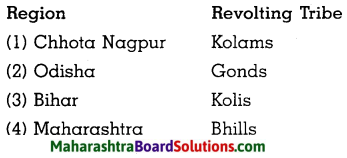
Answer:
Wrong pair: Bihar – Kolis
Corrected pair: Bihar – Santhals.
Name the following:
Question 1.
Led the revolt of Paikas:
Answer:
Bakshi Jaganbandhu Bidyadhar
Question 2.
Last Mughal Emperor of Delhi:
Answer:
Bahadur Shah
![]()
Question 3.
Led the revolt of Bhills in Khandesh:
Answer:
Kajarsingh
Question 4.
Led the revolt in Satpura:
Answer:
Shankarshah
Rewrite the statements by choosing the appropriate options:
Question 1.
In 1806, Indian soldiers at …………. revolted.
(a) Barrackpore
(b) Meerut
(c) Vellore
(d) Delhi
Answer:
(c) Vellore
Question 2.
Governor General …………… annexed many states through Doctrine of Lapse.
(a) Lord Warren Hastings
(b) Lord Cornwallis
(c) Lord Canning
(d) Lord Dalhousie
Answer:
(d) Lord Dalhousie
Question 3.
Bahadur Shah who led the revolt was imprisoned at …………… .
(a) Nepal
(b) Rangoon
(c) Sri Lanka
(d) Andaman
Answer:
(b) Rangoon
Question 4.
………… fought for ten months against British but was caught due to betrayal.
(a) Rango Bapuji
(b) Bakht Khan
(c) Tatya Tope
(d) Ahmedullah
Answer:
(c) Tatya Tope
![]()
Answer the following questions in one sentence:
Question 1.
Why did the Indian sepoys at Meerut rebel against the British?
Answer:
When the news that Mangal Pandey was arrested and hanged reached Meerut cantonment, the entire regiment of the Indian sepoys rebelled against the British.
Question 2.
In which parts of North India did the revolt spread?
Answer:
After Delhi, the revolt spread in Lucknow, Allahabad, Kanpur, Banaras, Bareli and Jhansi.
Question 3.
Who fought the Crimean War?
Answer:
The Crimean war was fought between Britain and Russia.
Question 4.
Which policy did the British adopt to pollute the minds of Indians?
Answer:
The British adopted the policy of ‘Divide and Rule’ to pollute the minds of the Indians.
Complete the graphical presentation:
Question 1.
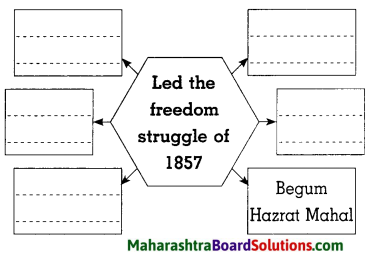
Answer:
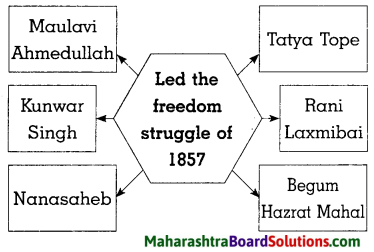
Question 2.
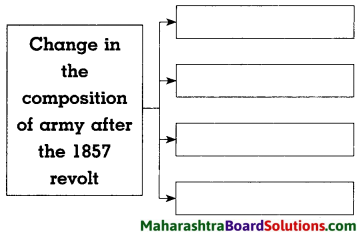
Answer:
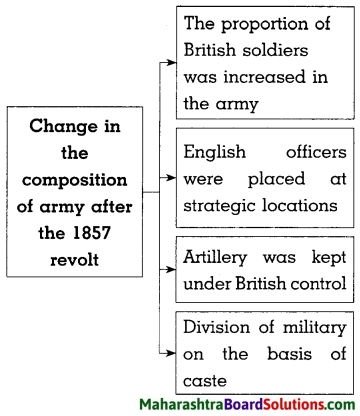
Question 3.
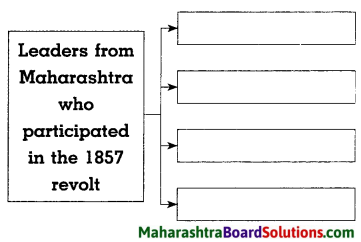
Answer:
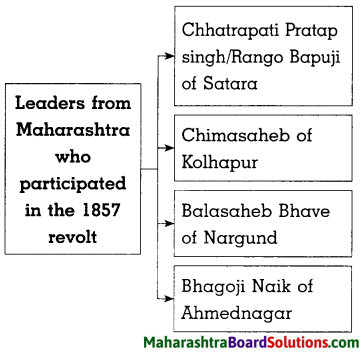
Write Short Notes :
Question 1.
Paika Rebellion:
Answer:
- There were many independent kingdoms in Odisha in the medieval period.
- The kings used to have a standing army known as Paikas.
- The kings gave them rent free land for their cultivation and livelihood.
- In return, they were supposed to fight along with the king in case of any war.
- The English conquered Odisha in 1803 and took over the hereditary rent free lands granted to the Paikas.
- This resulted in armed rebellion of the Paikas against the British under the leadership of Bakshi JaganbandhuBidyadhar.
![]()
Question 2.
Rebellion of Umaji Naik:
Answer:
1. Exploitation was on a large scale during the Company’s rule in India. There was rising discontent among the Indians. Sanyasis-Fakirs rebelled in the | Bengal province.
2. Umaji Naik organised the Ramoshis and the local youth and gave a strong fight to the British in Maharashtra.
3. They drafted a declaration and appealed to the people to support them in their fight against to overthrow the British government.
4. People in Ahmednagar, Satara, Pune, Nasik, Solapur and Bhor were inspired by them.
5. Umaji Naik was arrested and hanged to death in 1832 at Pune.
Explain the following statements with reasons:
Question 1.
There was discontent among the Indian soldiers.
Answer:
- Indian soldiers were treated with contempt.
- They were denied position higher than Subhedar in the army.
- They were given low status by the British officers.
- They were paid less salary than the British soldiers.
- Their allowances were reduced gradually.
- Due to all these factors there was discontent among the Indian soldiers.
Question 2.
Mangal Pandey was arrested and hanged.
Answer:
- The British introduced long Enfield rifles. The soldiers were required to bite the greased covering of the cartridges of the rifle to open them.
- The news spread among the Indian soldiers that the covering of the cartridges contained the fat of cows and pigs.
- The religious sentiments of the Muslim and Hindu soldiers were hurt.
- The angry soldiers who refused to use the cartridges were severely punished.
- In retaliation to this unjust practice, Mangal Pandey from Barrackpore cantonment fired at the British officer. So, he was arrested and hanged.
![]()
Answer the following questions in brief :
Question 1.
What changes were made in administration of India after the struggle of 1857?
Answer:
After the struggle of 1857, the British Parliament made the following changes in the administration of India :
- The rule of the East India Company came to an end.
- The Governor General was designated as Viceroy of India. He was entrusted with powers to rule over people of India.
- He carried administration under the control of British Parliament.
- A new post called Secretary of State was created in the British Government to look after the affairs of India.
Question 2.
Write about Queen’s Proclamation.
Answer:
- Queen Victoria of England issued a proclamation addressed to the people of India in 1858.
- She declared that the people in India were her subjects and that discrimination would not be made on grounds of race, religion, caste and place of birth.
- Government jobs will be given strictly on the basis of merit.
- She promised that government will not interfere in the religious matter of the people.
- She promised all the treaties made with the Indian rulers will be honoured and that no state would be annexed in future.
Read the given passage and answer the questions given below :
Questions :
Question 1.
Name the leaders of the struggle who lost their lives on the battlefield.
Answer:
Rani Laxmibai, Kunwar Singh, Ahmedullah laid their lives on the battle field.
Question 2.
Who was hanged to death?
Answer:
Tatya Tope fought for ten months but was caught by betrayal and hanged to death.
Question 3.
Which leaders took shelter in Nepal?
Answer:
Nanasaheb Peshwa and Begum Hazrat Mahal took shelter in Nepal.
![]()
Answer the following questions in detail :
Question 1.
Explain the reasons of the struggle of 1857 with following points :
(1) Economic
(2) Political
Answer:
The reasons of 1857 freedom struggle :
Economic :
- New revenue system | introduced by the British to increase their income and impoverish the peasants.
- The farmers had to either sell or mortgage their land to pay tax in cash.
- In order to sell British goods in India and earn profit they imposed heavy taxes on local industries.
- Many artisans lost their livelihood as 8 handicraft and textile industries ruined.
Political :
- The British captured many g states after winning the Battle of Plassey in 1757.
- Lord Dalhousie annexed many princely states on various reasons.
- He dethroned the Nawab of Ayodhya and annexed Ayodhya under the pretext of maladministration ?
- He annexed princely states of Jhansi, Nagpur and Satara through Doctrine of Lapse.
- Due to these policies of Lord Dalhousie the Indians had no trust in the British.
All these factors created discontent among artisans, princes and other classes f which ultimately led to the freedom struggle of 1857.
Question 2.
Write about the struggles before 1857.
Answer:
There was rising discontent among the Indians which led to many struggles before 1857 :
- The peasants in Bengal fought against the British from 1763 to 1857 first under the leadership of the Sanyasis and later the Fakirs.
- Umaji Naik in Maharashtra organised | Ramoshis and the local youths who fought against the British. The Kolis, the Bhills also fought against the British.
- They inspired people in Pune, Satara, Ahmednagar, Solapur, Nasik, Bhor, etc.
- Santhals in Bihar, Kolams in Chhota Nagpur and Gonds as well as Paikas in Odisha rebelled against the British.
- The Gadkaris in Kolhapur and Fond- ‘i Sawant in Konkan fought against the British.
- Zamindars, Princes and other classes in Gujarat, Rajasthan and South India gave a strong fight to the British.
Question 3.
How did the scope of the struggle increase?
Answer:
1. Mangal Pandey shot a British officer at Barrackpore cantonment who forced him to use cartridges greased with the fat of cows and pigs.
2. Mangal Pandey was arrested and hanged. News spread like fire to other cantonments.
3. The entire regiment of Indian soldiers at Meerut battled and marched towards Delhi.
4. On reaching Delhi, the rebels proclaimed Bahadur Shah as the Emperor of India.
5. It spread to the whole of north India. The soldiers in the cantonments from Bihar to Rajput ana participated in the revolt.
6. The revolt spread to Lucknow, Allahabad, Kanpur, Banaras, Bareli and Jhansi.
7. It spread to the whole of north India and in Nagpur, Satara, Kolhapur and Nargund, Khandesh in western India.
8. Many princely states, peasants and about 400 female Bhills participated in revolt at Khandesh to free themselves from the oppressive rule of the British.
9. The struggle was led by Bahadur Shah the Mughal Emperor, Nanasaheb Peshwa, Rani Laxmibai, Tatya Tope, Kunwar Singh of Bihar and Begum Hazrat Mahal of Ayodhya.
![]()
Question 4.
Why did the struggle fail?
Answer:
The reasons for the failure are as follows :
1. The struggle remained limited to the Northern part and it did not spread all over India at the same time.
2. Its intensity was severe in North India but Rajputana, Punjab but parts of Bengal and North-west India remained aloof.
3. Many princely states remained loyal to the British which reduced its intensity.
4. The majority of the rulers of the Indian states and the educated Indians kept away from the struggle.
5. Though the soldiers were brave they did not use military tactics.
6. As there was no commonly accepted leader to fight the British, there was no uniformity of the struggle.
7. On the other hand, the British had economic strength, experienced generals, disciplined army, latest weapons and modern means of transport and communication which made movements of the British swift.
8 The naval strength of the British was vast, while rebels were isolated.
Question 5.
What lesson have we learnt from the struggle of 1857?
Answer:
We learnt the following lesson from the struggle of 1857 :
1. Any challenge in front of the nation should be faced unitedly.
2. Each and every member of the society should keep in mind that if two people or groups disagree or have difference in opinion there are chances of third party creating misunderstanding and taking advantage of it. We need to be careful with such tendencies.
3. If the means to earn livelihood is taken away it creates discontent. Therefore, all should get means to earn livelihood.
4. The division in army, government offices and business should not be based on caste, race and religion. It should be based on merit and equality.
8th Std History Questions And Answers:
- Sources of History Class 8 History Questions And Answers
- Europe and India Class 8 History Questions And Answers
- Effects of British Rule Class 8 History Questions And Answers
- The Freedom Struggle of 1857 Class 8 History Questions And Answers
- Social and Religious Reforms Class 8 History Questions And Answers
- Beginning of Freedom Movement Class 8 History Questions And Answers
- Non-co-operation Movement Class 8 History Questions And Answers
- Civil Disobedience Movement Class 8 History Questions And Answers
- Last Phase of Struggle for Independence Class 8 History Questions And Answers
- Armed Revolutionary Movement Class 8 History Questions And Answers
- Struggle for Equality Class 8 History Questions And Answers
- India Gains Independence Class 8 History Questions And Answers
- Fulfillment of Struggle for Independence Class 8 History Questions And Answers
- Formation of State of Maharashtra Class 8 History Questions And Answers